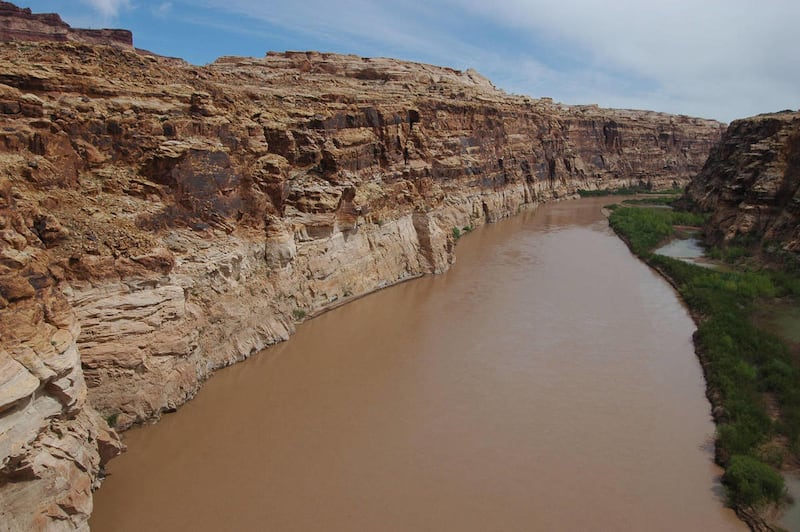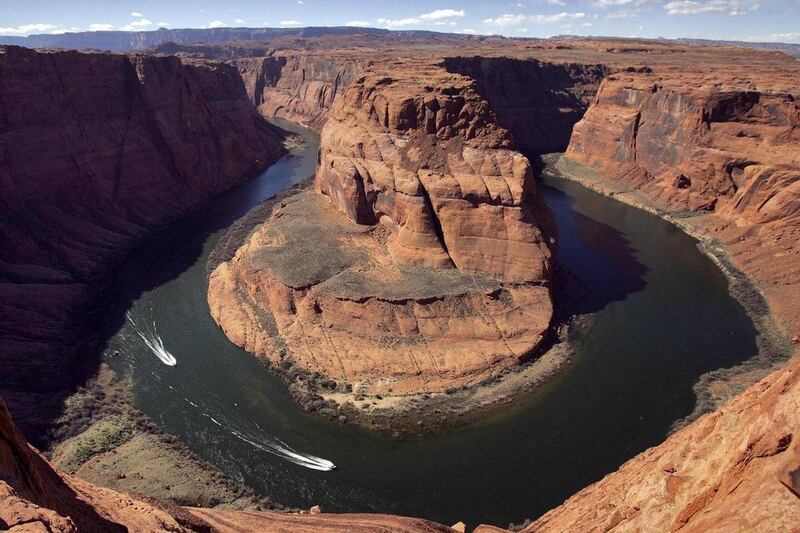This is the worst 14-year-drought in the last hundred years. – Larry Walkoviak
SALT LAKE CITY — The Colorado River has reached historic lows, prompting the federal government to take emergency steps Friday to curtail releases from Lake Powell, turning the faucet to its lowest drip since the reservoir filled in the 1960s.
“This is the worst 14-year drought period in the last hundred years,” said Upper Colorado Regional Director Larry Walkoviak.
Under 2007 shortage guidelines, the delivery of water from Lake Powell to downstream Lake Mead will be reduced to 7.48 million acre-feet in the upcoming water year, which begins Oct. 1.
The action by the U.S. Bureau of Reclamation led Pat Mulroy, head of the water district that serves the Las Vegas metropolitan area, to call for federal disaster relief, arguing the potential for damage is comparable to East Coast hurricanes.
Lake Mead, the area's chief source of water, is projected to decline an additional 8 feet during 2014 as a result of the lower annual Lake Powell release.
Lake Powell is 45 percent full, dropping to a level that triggered the reduction from 8.23 million acre-feet.
Mulroy's Southern Nevada Water Authority is in a race against Mother Nature, rushing to put in a third intake in a deeper part of the reservoir from which to withdraw water. The fear is the reservoir could drop to levels low enough that the other intakes would not work.
Conservation groups warned that the federal action dramatically increases the chance for an unprecedented water crisis in the West, where 30 million people depend on the Colorado River for its water supply. The river also is the lifeblood of agriculture in much of the basin states, where more than 90 percent of pasture and cropland requires irrigation.
The river also supports a $26 billion recreation economy that employs a quarter-million Americans.
“On the west slope, outdoor recreation is a major part of the economy and depends on healthy habitat in the Colorado River. Agriculture also depends on healthy river flows. We’re all in this boat together," said Drew Peternell, director of Trout Unlimited's Colorado Water Project. "We have to implement cooperative solutions that work for everyone.”
Gary Wockner, campaign coordinator for Save the Colorado, said the federal action should be a signal that the Colorado River cannot support any more diversions.
"There's no more extra water in the system. If you take water out upstream, then someone downstream is going dry," Wockner said. "So we can't divert any more water out of the Colorado River or build any new water supply projects."
But Steve Erickson with the Great Basin Water Network said the Colorado River shortages could hasten the urgency to develop what water is left in the system.
"That's been the thinking before, to build their way out of the problem," Erickson said. "We have to take a much more nuanced approach."
Shortages of water deliveries to Nevada, in particular, may further stoke the Southern Nevada Water Authority's pursuit of a groundwater pumping project in the eastern basins of Nevada.
"Pat Mulroy would not be alone in calling for development in order to address this crisis," Erickson said. "While we are most concerned that hitting that trigger point would be going ahead with the SNWA groundwater development and pipeline project, it would not be the only development diversion of concern."
The Colorado River is already over-allocated, and the bureau's supply and demand study released earlier this year projects shortfalls of 3.24 million acre-feet by 2060.
If the drying trends continue, groups worry that a nightmarish scenario could play out for the West. Those possibilities include:
Lower water levels could cut off power production at Glen Canyon Dam as soon as the winter of 2015, affecting power supply and pricing in six states.
Less water coming into Lake Mead may bring the level below an intake pipe that delivers water to Las Vegas by the spring of 2015.
By the winter of 2015, Lake Mead may also dip to a level that will result in a major decline in power generation at Hoover Dam, affecting supply and cost of power for consumers in three states, including California.
The bureau's Lower Colorado Regional Director Terry Fulp did point to the unpredictability and variability in the Colorado River system.
“With a good winter snowpack next year, the outlook could change significantly as it did in 2011, but we also need to be prepared for continuing drought," he said.
At present, the longer-term projections from the agency's hydrologic models show a very small chance of lower basin delivery shortages in 2015, with the first significant chance of reduced water deliveries in the lower basin in 2016.
Email: amyjoi@deseretnews.com
Twitter: amyjoi16



